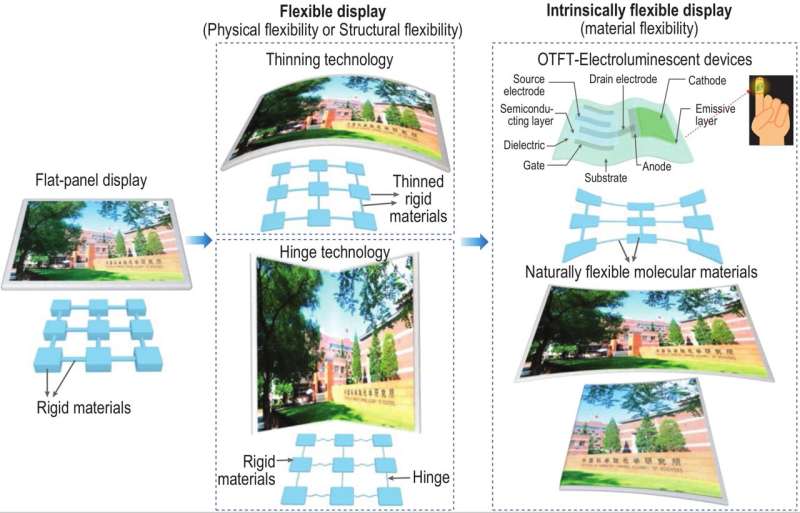Technically, there are different routes for the realization of flexibility. 1) Physical flexibility: any rigid material that is extremely thin or has a very small diameter can be flexible. 2) Structural flexibility: for example, the wire-connecting fractal and spring configuration can provide macroscopic flexibility for the rigid chip. 3) Intrinsic flexibility: the materials in this device have flexible and stretchable nature. Different from the flexible and stretchable devices, the intrinsically flexible displays should simultaneously satisfy three critical requirements: large elastic deformation, small bending radius below 0.5 mm, and high stretching strain above 25%, which decides whether they can be subsequently conformed, folded, or rolled. With these three conditions, intrinsically flexible displays can change the perception of information that frequently appears in almost all aspects of our lives. Credit: Science China Press
This review is conceived by academician Yunqi Liu and professor Yunlong Guo (Institute of Chemistry, Chinese Academy of Sciences). Dr. Zhiyuan Zhao, Dr. Kai Liu, and Yanwei Liu are the co-first authors. This research attaches significant attention to the key materials for intrinsically flexible organic thin film transistors (OTFTs) and electroluminescent devices. Specifically, we focus on the following five aspects: intrinsically flexible electrode materials, organic semiconductors (OSCs) and dielectric materials for OTFTs, intrinsically flexible organic emissive semiconductors (OESCs) for electroluminescent devices, and OTFT-driven electroluminescent devices for intrinsically flexible displays. Lastly, the future challenges and opportunities about intrinsically stretchable OTFT-driven displays are presented.
Intrinsically flexible electrodes materials should be characterized with excellent electrical conductivity, high mechanical stretchability, transparency, ideal adhesion, suitable work function, good chemical stability, and biocompatibility. The authors provide a detailed summary of current stretchable electrode materials, including carbon nanotubes (CNTs), graphene, metal nanowires (MNWs), conducting polymers (CPs) and their hybrid materials.
Intrinsically flexible organic semiconductors are an important component for thin-film transistors. The current strategies are mainly divided into the following categories: structurally designing polymer chains through the incorporation of conjugation-break spacers (CBs) and flexible chain segments, controlling molecular weight and regioregularity of conjugated polymers, and blending with elastomer polymers or molecular additives.
Intrinsically flexible dielectric material is close to the semiconductor layer, and significantly affects the electrical performance of transistors. Presently, common elastomeric dielectric materials include PU, PDMS, and SEBS. However, these elastomeric dielectrics typically show low dielectric constant, thus increasing the power consumption of the devices. This review proposed some strategies to develop high-k and high-stretchability dielectric polymers.
Intrinsically flexible organic light-emitting semiconductors are prepared only by introducing flexible chains in the polymer matrix, so as to balance the mechanical compliance and luminous capacities of organic light-emitting semiconductors. Therefore, exploiting some new design methodology to improve the mechanical properties of materials is an important direction for the development of such materials.
Intrinsic flexible electroluminescent devices mainly include polymer light-emitting diodes (PLEDs), organic light-emitting electrochemical cells (OLECs), and stretchable alternating current electroluminescence (ACEL). Due to the limitation by the properties of intrinsically stretchable electroluminescent materials, currently reported intrinsically flexible electroluminescent devices are mainly realized by the doping or blending methods.
Finally, the authors put forward some suggestions and prospects for the future development of intrinsically flexible displays. The research was published in National Science Review.
More information: Zhiyuan Zhao et al, Intrinsically flexible displays: key materials and devices, National Science Review (2022). DOI: 10.1093/nsr/nwac090
Provided by Science China Press
























